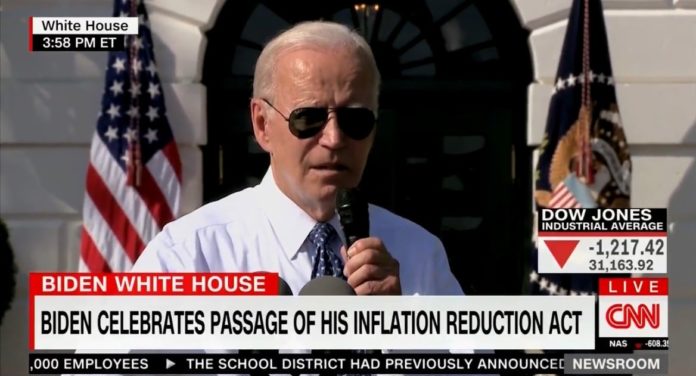The U.S. Department of Agriculture recently released a report that forecast food inflation to remain high for 2023 at 7.1 percent, a modest improvement from 2022’s increase of 9.9 percent. Some key foods are predicted to increase in price close to or well over ten percent this year while some are predicted to slightly decrease. The prediction range is for food prices to increase anywhere from 4.2 percent to 10.1 percent.

Wages have not kept up with overall inflation since Joe Biden took office in 2021 as this chart by Statistica shows:
Wages have fared even worse against food inflation and will likely continue to fail to keep up in 2023. SNAP benefits (Supplemental Nutrition Assistance Program, formerly food stamps) recipients will see a generous 12.5 percent increase for 2023. Social Security recipients will receive an increase of 8.7 percent.
TRENDING: JUDICIAL COUP: Biden Filling Courts with Radical Judges Who Will Put Politics Before the Law
Excerpt from USDA report released January 23:
…In 2022, food prices increased by 9.9 percent. Food-at-home prices increased by 11.4 percent, while food-away-from-home prices increased by 7.7 percent. All food price categories tracked by the U.S. Department of Agriculture (USDA), Economic Research Service (ERS) increased by more than 5 percent. Following an outbreak of Highly Pathogenic Avian Influenza (HPAI), egg prices had the largest price increase (32.2 percent) of any category tracked by ERS between 2021 and 2022. Beef and veal prices increased the least (5.3 percent) between 2021 and 2022 and generally declined from peak prices in November 2021. Eleven food-price categories increased by more than 10 percent, including fats and oils (18.5 percent), poultry (14.6 percent), other meats (14.2 percent), cereals and bakery products (13.0 percent), other foods (12.7 percent), dairy products (12.0 percent), processed fruits and vegetables (12.0 percent), nonalcoholic beverages (11.0 percent), and sugar and sweets (10.4 percent). All food categories grew faster than their historical average rate, and the 20-year average inflation rate increased for all food categories.
Food prices are expected to grow more slowly in 2023 than in 2022 but still at above historical average rates. In 2023, all food prices are predicted to increase 7.1 percent, with a prediction interval of 4.2 to 10.1 percent. Food-at-home prices are predicted to increase 8.0 percent, with a prediction interval of 4.5 to 11.7 percent. Food-away-from-home prices are predicted to increase 8.2 percent, with a prediction interval of 6.7 to 9.7 percent.
Retail egg prices increased 11.1 percent in December 2022 and reached 59.9 percent above December 2021 prices. The ongoing outbreak of HPAI continues to reduce the U.S. egg-layer flock, as well as the poultry flock to a lesser extent. This decrease is expected to increase wholesale and retail egg prices for the coming months. The HPAI outbreak has contributed to elevated egg and poultry prices as over 57 million birds, 300 commercial flocks, and 47 States have been affected. Price impacts of the outbreak will be monitored closely. Egg prices are predicted to increase 27.3 percent in 2023, with a prediction interval of 6.9 to 52.0 percent. This wide prediction interval reflects the volatility in retail egg prices.
Prices are expected to continue increasing for eight additional food categories that experienced consistent growth throughout 2022. In 2023, prices are predicted to increase for other meats (12.8 percent), dairy products (8.0 percent), fats and oils (16.5 percent), processed fruits and vegetables (9.6 percent), sugar and sweets (10.6 percent), cereals and bakery products (12.0 percent), nonalcoholic beverages (8.7 percent), and other foods (6.8 percent). The prediction intervals of each of these categories is strictly above zero.
Price decreases are expected for three price categories. Beef and veal prices are predicted to decrease 1.8 percent in 2023, with a prediction interval of -10.4 to 8.0 percent; pork prices are predicted to decrease 3.0 percent, with a prediction interval of -10.3 to 5.1 percent; and fresh fruit prices are predicted to decrease 1.7 percent, with a prediction interval of -7.5 to 4.5 percent.
2023 increased SNAP benefits by size of household compared with 2022 (excerpt via Yahoo):
Cost-of-Living AdjustmentSNAP benefits are adjusted annually based on the rate of inflation. The announced increase in payments for 2023 — which technically started Oct. 1, 2022 — was 12.5%. This means that households receiving $500 in SNAP benefits from Oct. 1, 2021, to Sep. 30, 2022, will see an increase to $562.50 for this year.
Higher Top PayoutsStarting Oct. 1, 2022, and running until Sept. 30, 2023, SNAP recipients will see higher maximum benefit amounts. The values vary depending on the size of the qualifying household, as follows:
One-person: $281 vs. $250; Two-person: $516 vs. $459; Three-person: $740 vs. $658; Four-person: $939 vs. $835; Five-person: $1,116 vs. $992; Six-person: $1,339 vs. $1,190; Seven-person: $1,480 vs. $1,316; Eight-person: $1,691 vs. $1,504,Each additional person: $211 vs. $188



